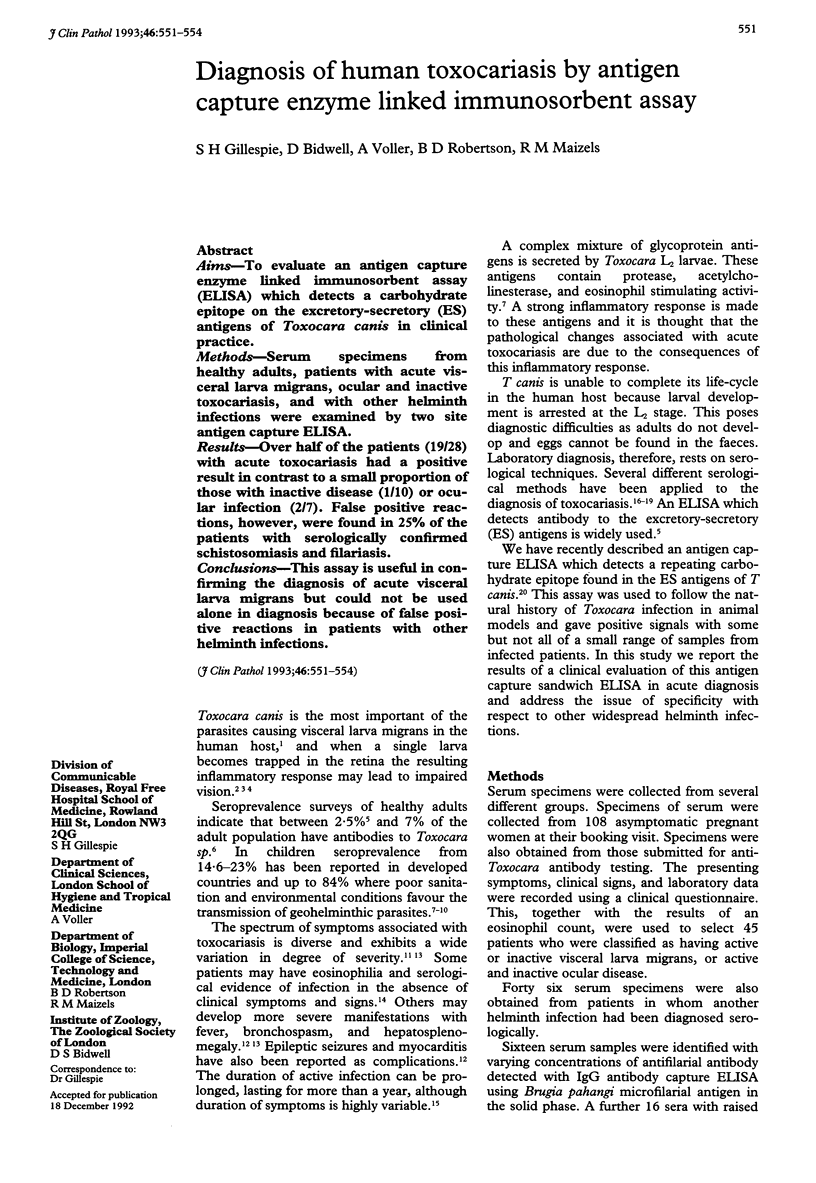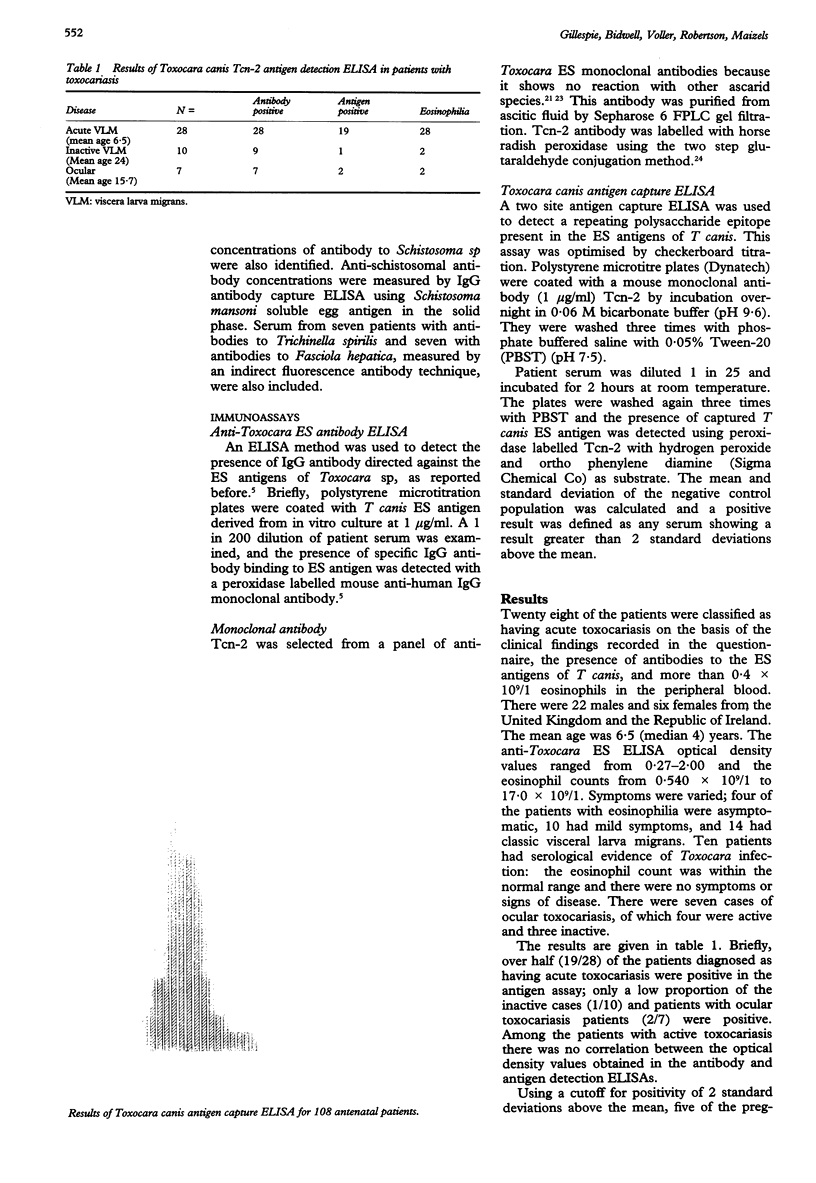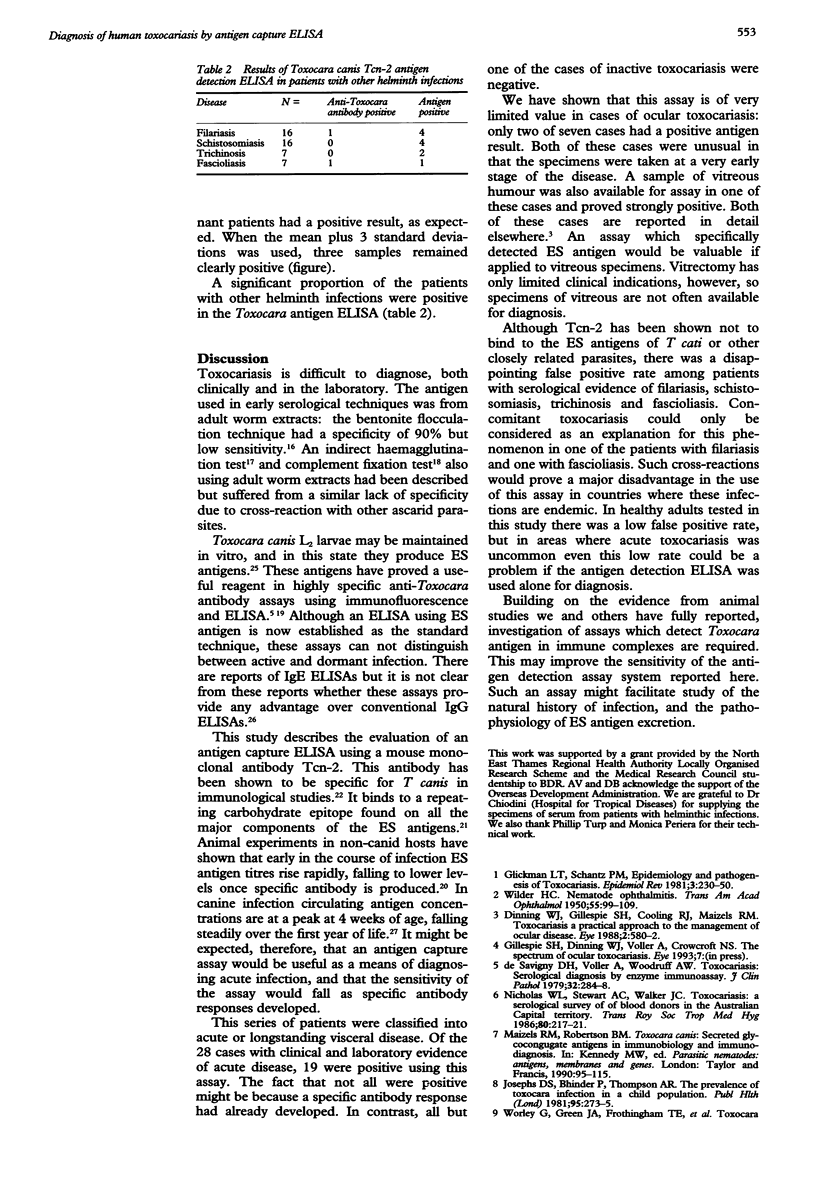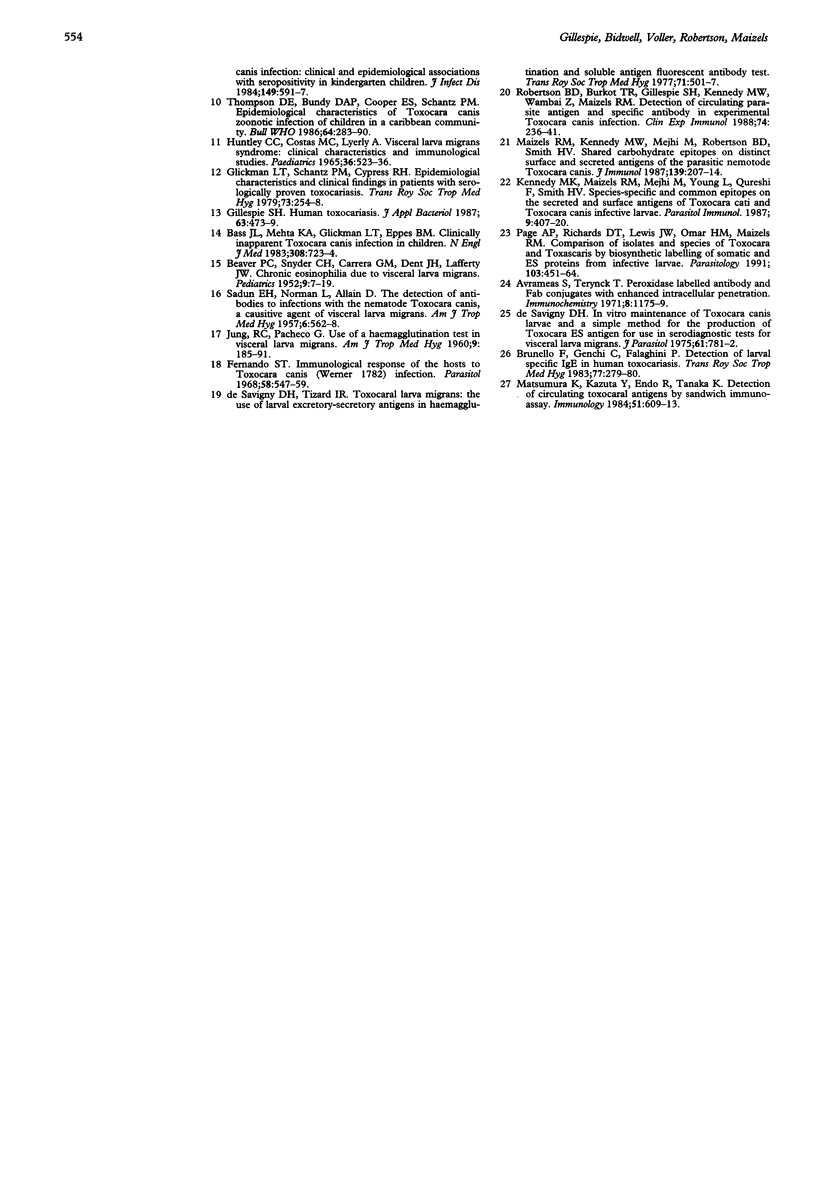Abstract
AIMS--To evaluate an antigen capture enzyme linked immunosorbent assay (ELISA) which detects a carbohydrate epitope on the excretory-secretory (ES) antigens of Toxocara canis in clinical practice. METHODS--Serum specimens from healthy adults, patients with acute visceral larva migrans, ocular and inactive toxocariasis, and with other helminth infections were examined by two site antigen capture ELISA. RESULTS--Over half of the patients (19/28) with acute toxocariasis had a positive result in contrast to a small proportion of those with inactive disease (1/10) or ocular infection (2/7). False positive reactions, however, were found in 25% of the patients with serologically confirmed schistosomiasis and filariasis. CONCLUSIONS--This assay is useful in confirming the diagnosis of acute visceral larva migrans but could not be used alone in diagnosis because of false positive reactions in patients with other helminth infections.
Full text
PDF



Images in this article
Selected References
These references are in PubMed. This may not be the complete list of references from this article.
- Avrameas S., Ternynck T. Peroxidase labelled antibody and Fab conjugates with enhanced intracellular penetration. Immunochemistry. 1971 Dec;8(12):1175–1179. doi: 10.1016/0019-2791(71)90395-8. [DOI] [PubMed] [Google Scholar]
- BEAVER P. C., SNYDER C. H., CARRERA G. M., DENT J. H., LAFFERTY J. W. Chronic eosinophilia due to visceral larva migrans; report of three cases. Pediatrics. 1952 Jan;9(1):7–19. [PubMed] [Google Scholar]
- Bass J. L., Mehta K. A., Glickman L. T., Eppes B. M. Clinically inapparent Toxocara infection in children. N Engl J Med. 1983 Mar 24;308(12):723–724. doi: 10.1056/nejm198303243081216. [DOI] [PubMed] [Google Scholar]
- Brunello F., Genchi C., Falagiani P. Detection of larva-specific IgE in human toxocariasis. Trans R Soc Trop Med Hyg. 1983;77(2):279–280. doi: 10.1016/0035-9203(83)90096-2. [DOI] [PubMed] [Google Scholar]
- Dinning W. J., Gillespie S. H., Cooling R. J., Maizels R. M. Toxocariasis: a practical approach to management of ocular disease. Eye (Lond) 1988;2(Pt 5):580–582. doi: 10.1038/eye.1988.108. [DOI] [PubMed] [Google Scholar]
- Fernando S. T. Immunological response of the hosts to Toxocara canis (Werner, 1782) infection. I. Effect of superinfection on naturally infected puppies. Parasitology. 1968 Aug;58(3):547–559. doi: 10.1017/s0031182000028857. [DOI] [PubMed] [Google Scholar]
- Gillespie S. H. Human toxocariasis. J Appl Bacteriol. 1987 Dec;63(6):473–479. doi: 10.1111/j.1365-2672.1987.tb02716.x. [DOI] [PubMed] [Google Scholar]
- Glickman L. T., Schantz P. M., Cypess R. H. Epidemiological characteristics and clinical findings in patients with serologically proven toxocariasis. Trans R Soc Trop Med Hyg. 1979;73(3):254–258. doi: 10.1016/0035-9203(79)90077-4. [DOI] [PubMed] [Google Scholar]
- Glickman L. T., Schantz P. M. Epidemiology and pathogenesis of zoonotic toxocariasis. Epidemiol Rev. 1981;3:230–250. doi: 10.1093/oxfordjournals.epirev.a036235. [DOI] [PubMed] [Google Scholar]
- Huntley C. C., Costas M. C., Lyerly A. Visceral larva migrans syndrome: clinical characteristics and immunologic studies in 51 patients. Pediatrics. 1965 Oct;36(4):523–536. [PubMed] [Google Scholar]
- JUNG R. C., PACHECO G. Use of a hemagglutination test in visceral larva migrans. Am J Trop Med Hyg. 1960 Mar;9:185–191. doi: 10.4269/ajtmh.1960.9.185. [DOI] [PubMed] [Google Scholar]
- Josephs D. S., Bhinder P., Thompson A. R. The prevalence of Toxocara infection in a child population. Public Health. 1981 Sep;95(5):273–275. doi: 10.1016/s0033-3506(81)80018-2. [DOI] [PubMed] [Google Scholar]
- Kennedy M. W., Maizels R. M., Meghji M., Young L., Qureshi F., Smith H. V. Species-specific and common epitopes on the secreted and surface antigens of Toxocara cati and Toxocara canis infective larvae. Parasite Immunol. 1987 Jul;9(4):407–420. doi: 10.1111/j.1365-3024.1987.tb00519.x. [DOI] [PubMed] [Google Scholar]
- Maizels R. M., Kennedy M. W., Meghji M., Robertson B. D., Smith H. V. Shared carbohydrate epitopes on distinct surface and secreted antigens of the parasitic nematode Toxocara canis. J Immunol. 1987 Jul 1;139(1):207–214. [PubMed] [Google Scholar]
- Matsumura K., Kazuta Y., Endo R., Tanaka K. Detection of circulating toxocaral antigens in dogs by sandwich enzyme-immunoassay. Immunology. 1984 Mar;51(3):609–613. [PMC free article] [PubMed] [Google Scholar]
- Nicholas W. L., Stewart A. C., Walker J. C. Toxocariasis: a serological survey of blood donors in the Australian Capital Territory together with observations on the risks of infection. Trans R Soc Trop Med Hyg. 1986;80(2):217–221. doi: 10.1016/0035-9203(86)90015-5. [DOI] [PubMed] [Google Scholar]
- Page A. P., Richards D. T., Lewis J. W., Omar H. M., Maizels R. M. Comparison of isolates and species of Toxocara and Toxascaris by biosynthetic labelling of somatic and ES proteins from infective larvae. Parasitology. 1991 Dec;103(Pt 3):451–464. doi: 10.1017/s0031182000059977. [DOI] [PubMed] [Google Scholar]
- Robertson B. D., Burkot T. R., Gillespie S. H., Kennedy M. W., Wambai Z., Maizels R. M. Detection of circulating parasite antigen and specific antibody in Toxocara canis infections. Clin Exp Immunol. 1988 Nov;74(2):236–241. [PMC free article] [PubMed] [Google Scholar]
- SADUN E. H., NORMAN L., ALLAIN D. The detection of antibodies to infections with the nematode, Toxocara canis, a causative agent of visceral larva migrans. Am J Trop Med Hyg. 1957 May;6(3):562–568. doi: 10.4269/ajtmh.1957.6.562. [DOI] [PubMed] [Google Scholar]
- Savigny D. H. In vitro maintenance of Toxocara canis larvae and a simple method for the production of Toxocara ES antigen for use in serodiagnostic tests for visceral larva migrans. J Parasitol. 1975 Aug;61(4):781–782. [PubMed] [Google Scholar]
- Thompson D. E., Bundy D. A., Cooper E. S., Schantz P. M. Epidemiological characteristics of Toxocara canis zoonotic infection of children in a Caribbean community. Bull World Health Organ. 1986;64(2):283–290. [PMC free article] [PubMed] [Google Scholar]
- WILDER H. C. Nematode endophthalmitis. Trans Am Acad Ophthalmol Otolaryngol. 1950 Nov-Dec;55:99–109. [PubMed] [Google Scholar]
- Worley G., Green J. A., Frothingham T. E., Sturner R. A., Walls K. W., Pakalnis V. A., Ellis G. S., Jr Toxocara canis infection: clinical and epidemiological associations with seropositivity in kindergarten children. J Infect Dis. 1984 Apr;149(4):591–597. doi: 10.1093/infdis/149.4.591. [DOI] [PubMed] [Google Scholar]
- de Savigny D. H., Tizard I. R. Toxocaral larva migrans: the use of larval secretory antigens in haemagglutination and soluble antigen fluorescent antibody tests. Trans R Soc Trop Med Hyg. 1977;71(6):501–507. doi: 10.1016/0035-9203(77)90144-4. [DOI] [PubMed] [Google Scholar]
- de Savigny D. H., Voller A., Woodruff A. W. Toxocariasis: serological diagnosis by enzyme immunoassay. J Clin Pathol. 1979 Mar;32(3):284–288. doi: 10.1136/jcp.32.3.284. [DOI] [PMC free article] [PubMed] [Google Scholar]



